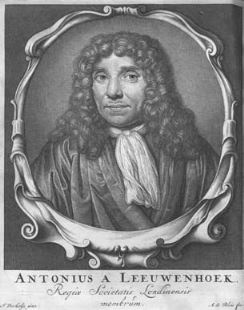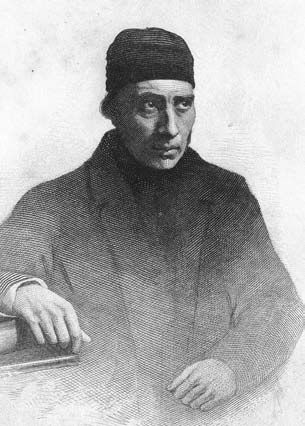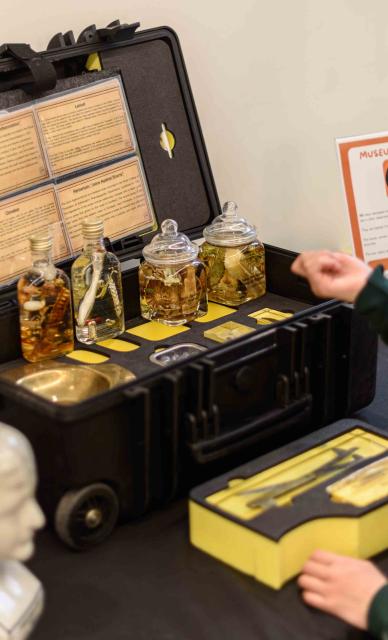Support us
As a charity we rely on your donations to fund our free exhibitions, school activities and online resources
Empowering medical excellence, shaping healthcare futures.
The idea that certain diseases were caused by minute living creatures invisible to the human eye goes back more than 2,000 years. The Roman scholar Marcus Varro was director of the imperial library at Rome and the author of the above work on agriculture. Varro warned against locating homesteads in the proximity of swamps ‘because there are bred certain minute creatures which cannot be seen by the eyes, which float in the air and enter the body through the mouth and nose and there cause serious diseases’.

Fracastoro (pictured) stated that there were diseases that could be caused by a contagion which ‘passes from one thing to another’. These were transmitted in three ways: by direct contact with the infected, by contact with their clothes or carried by the air. Fracastoro described this agent of contagion as seminaria, a word which has often been translated as germs. Its literal meaning, however, is breeding ground or nursery. Although he stated contagion was effected by ‘small imperceptible particles’, Fracastoro never perceived these particles to be living creatures. He did speculate, however, that each disease had its own specific seminaria, an idea that was neglected for more than 300 years.
Kircher was a Jesuit priest and scholar who wrote on a wide variety of subjects. In 1656 he attempted to find the cause of a virulent outbreak of bubonic plague by studying the blood of the victims under a microscope. He described how he found it to be full of ‘little worms which propagate plague, so very small and unperceivable except with a very fine microscope’. This is regarded to be the first clear statement of the germ theory of disease based on microscopical examination.

The invention of the microscope revolutionised the study of infectious diseases. Hooke’s Micrographia was the first work entirely devoted to an account of microscopical observations. The accurate illustrations (see plate illustrated as an example), engraved by Hooke himself, include the first published depiction of a microorganism. Hooke examined a ‘small white spot of a hairy mould’ taken from the sheepskin cover of a book. He called the organism a ‘microscopical mushroom’. Mycologists now identify Hooke’s specimen as the microfungus Mucor.
Although Needham practised as a physician, he is best known as a political writer and pioneer journalist. Ahead of most of the medical profession, however, Needham recognised the importance of Kircher’s discoveries and was the first to report on them and translate them into English. This work has been described as the first English publication on bacteriology.

The Dutch shopkeeper Leeuwenhoek had an obsession for microscopes and a talent for lens grinding. For more than 50 years he made important observations in every branch of natural science. After studying samples of plaque and spittle, Leeuwenhoek wrote to the Royal Society that he found ‘an unbelievably great company of living animalcules… in such enormous numbers, that all the water … seemed to be alive’. Although he never connected these creatures with disease, his observations and drawings are the first recorded descriptions of micro-organisms.
Pringle’s work established the basic principles of the sanitation and ventilation of hospital wards and military quarters. It also contains the first use of the word ‘antiseptic’. In early editions Pringle had conceived contagion as due to ‘putrid exhalations from the humours’, but by the fourth edition he had ‘perused the curious dissertation, published by Linnaeus, in favour of Kircher’s system of contagion by animalcula, [arguing that] it seems reasonable to suspend all hypotheses, till that matter is further inquired into’. He then writes that scabies is ‘best accounted for by Leeuwenhoek, from certain small insects he discovered in the postules by the microscope’.
Alexander Gordon of Aberdeen was the first to suggest that puerperal fever was contagious. ‘It is a disagreeable declaration … that I myself was the means of carrying the infection to a great number of women.’ Fifty years before Holmes and Semmelweis, Gordon wrote that he had ‘evident proofs that every person who had been with a patient in the puerperal fever became charged with an atmosphere of infection, which was communicated to every pregnant woman who happened to come within its sphere. This is not an assertion, but a fact.’ He recommended that midwives and doctors should ‘carefully wash themselves, and to get their apparel properly fumigated before it be put on again’.

The belief in poisonous miasmas still prevailed, but the idea that disease was caused by micro-organisms began to find support. Henry Holland (pictured), physician to Queen Victoria, wrote: ‘We have sufficient proof through recent discoveries, that these morbid actions from parasitic animals are much more numerous and varied than has heretofore been believed. It seems certain that future research will still further increase the number within our knowledge, and while indicating, by aid of the microscope, forms more minute than those yet discovered, will in this very minuteness suggest their more extensive agency as causes of disease.’

It has been suggested that the first person to recognise and cure a bacterial infection was the Scottish surgeon John Goodsir (pictured). Examining the vomit of a sick boy under the microscope, Goodsir identified a vegetable organism as the cause of the disease. He named this organism Sarcina ventriculi and successfully treated the patient with sodium hyposulphite and weak carbolic acid.
Pasteur’s discoveries on fermentation in wine, beer and milk demonstrated that it was microorganisms in the atmosphere that produced fermentation diseases. This proof of external contamination was to finally overturn the theory of the spontaneous generation of microorganisms caused by internal or systematic imbalances. The report of his experiments in the above article has been called ‘the manifesto of the germ theory’. It set forth the fundamental concepts from which the science of microbiology would develop.

Support us
As a charity we rely on your donations to fund our free exhibitions, school activities and online resources